
Deposition Date
2019-11-14
Release Date
2020-07-22
Last Version Date
2023-11-22
Entry Detail
PDB ID:
6LBJ
Keywords:
Title:
Structure of mouse GLD-2 (Terminal nucleotidyltransferase 2, TENT2)
Biological Source:
Source Organism:
Mus musculus (Taxon ID: 10090)
Host Organism:
Method Details:
Experimental Method:
Resolution:
2.70 Å
R-Value Free:
0.27
R-Value Work:
0.25
R-Value Observed:
0.25
Space Group:
P 1


